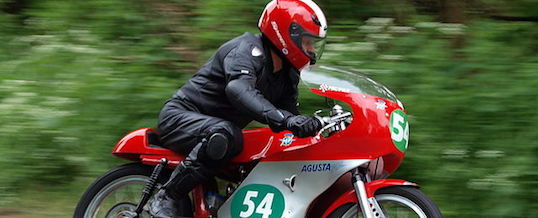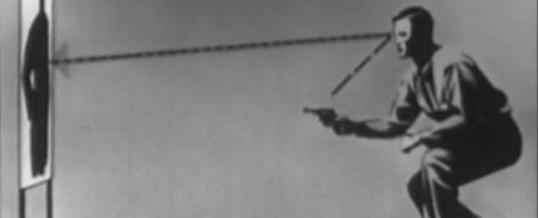
Incident Analysis: Road raging car vs. motorcycle. How would you handle it?
I’ve spoken before about the need to be able to protect yourself when you’re not armed, and today’s topic is a perfect example: a video of a motorcycle versus car road rage incident from Florida shows the need to defend yourself when a firearm is either not available or is not the right choice. Not every lethal threat is a shooting situation!
First, watch the video:
Something to keep in mind: we don’t know what precipitated this video. For all we know the motorcyclist may have done something to make the guy in the car mad, and then it became a mutual antagonistic ritual. All of the road rage incidents I’ve witnessed were mutual affairs: one person does something stupid in traffic, the second person takes personal offense to what was often nothing more than a simple driving error, the first person ups the hostility by replying personally to the personal affront, and then things get ugly.
There are certainly a percentage of people out there who get immediately violent at the initial provocation, but of those I’ve seen the saying “it takes two to tango” certainly applies. Letting things roll off your back, I believe, is probably your best defense against a road rage incident.
If the motorcyclist had kept his mind on the game, he could have ended the situation before it got really dangerous. (Not that the car driver’s swerving in front of him at the beginning wasn’t dangerous, but it got worse.) I lost count of the number of times commenters on Facebook said that “he should have had a gun” or, worse, that he “should have pumped some bullets into the car.” This is not (yet) a gun situation, and having one would not have kept him from making the mistakes he did. Let’s consider what you can do if you’re on a motorcycle and confronted with an unreasonably angry person in a car.
What do I know about motorcycles?
I rode a motorcycle as my preferred mode of transport for more than a decade, and as a secondary transport for many years before and after; I’ve got a lot of two-wheel miles under my belt, and none of them were of the once-a-year-freeway-trip that most people point to as their motorcycling career. This would be an easy claim if I lived in, say, Arizona; here in Oregon, riding year-round is a bigger education but requires substantially more dedication (and a really good rain suit!)
Most of my miles were on Italian sportbikes, often traveling at what can only be described as slightly-not-quite-legal rates of speed. I survived to tell the tale, and learned a lot in the process (taking a riding class and hanging out with guys who taught people to race motorcycles on real tracks helped tremendously.)
Your motorcycle can have five primary strengths compared to a car:
- Better acceleration*
- Better deceleration*
- Better low speed maneuverability
- Narrower profile
- Better ground clearance**
Interestingly, a large number of the motorcyclists I’ve known believed their rides to have strengths that they didn’t. Your motorcycle is not going have:
- A higher top speed than most cars
- Superior high-speed maneuverability compared to most cars
If your response to an incident relies on either of those, you’re likely to lose.
The rider in this video made some mistakes and didn’t take advantage of what his machine could do. First, he kept going in a straight line in the same direction of travel as his aggressor. Second, he adopted a bad strategy to throw off his pursuer (riding into oncoming traffic) that was both ineffective and possibly more dangerous than the threat he faced. Finally, he assumed that he had a weapon (high top speed) that he didn’t; he couldn’t travel fast enough to outpace even the economy sedan that was following him.
What could he have done?
First, at the 13-second mark he didn’t need to flip off the driver. Remember what I said about mutual escalation? Again, we don’t know what went on before this video but that universally insulting gesture certainly didn’t do anything to calm the situation.
As he comes to the intersection and turns right he misses a huge chance to both interrupt the incident and take advantage of his bike’s abilities. He could have quickly accelerated as he made the corner, taking advantage of his low-speed maneuverability and power, and then braked hard and turned into the corner gas station. The combination would have been difficult for the driver to follow, and if the biker had combined that with an exit in the opposite direction from the other station entrance (possibly using his narrower profile to squeeze between cars in the station and waiting for the light) he would have greatly decreased the odds of the car being either willing or able to follow.
This is something that I’ve noticed repeatedly about road rage incidents: the “defender” never seems to want to break from his original path, instead doggedly maintaining his original or desired direction of travel. Whether in a car or on a motorcycle, if you’re faced with someone who is unreasonably aggressive and you believe wants to do you harm, change your direction of travel. Directly opposite is your best bet, even if it means you’re a few minutes late to your appointment.
A motorcycle’s acceleration advantage only lasts a few seconds; the car will eventually catch up. Accelerating is not a tool if all you do is use it to get to your top speed while continuing to travel in a straight line, which is what this guy did.
As they were going down that straight street there were numerous chances for the motorcyclist to brake hard, use his maneuverability advantage to turn into the opposite lane of travel (either because of a crossing or simply through the median) and accelerate hard until he came to the next side street. He could then brake hard again, turn 90-degrees, accelerate hard, and do the same thing at the next intersection. This would have given him a “U” travel path followed by a “Z” path (perhaps multiple “Z” paths) that would have made it nearly impossible for the auto driver to find him, let alone follow.
As the pair traveled into the countryside the opportunities for the motorcyclist to play to his strengths diminished rapidly. You’ll see that the road turns into a country highway with fewer turn-offs and intersections, which means fewer chances to get away. It’s the equivalent of being boxed into a corner.
How to prepare to defend against a car threat
Learn what both you and your bike can actually do when pushed (if you don’t know what countersteering is, you aren’t there yet.) Remember that you have some definite advantages over the vast majority of cars, but they aren’t the advantages you might think; simply twisting the throttle is not likely to solve the problem.
If faced with this kind of situation, don’t escalate; if you’re being pursued anyhow, keep your cool and think ahead — look for road features (corners, side streets, etc.) that you can use to set-up a getaway that takes advantage of your bike’s true abilities. Finally, don’t stay mindlessly committed to your original direction of travel. Getting there a little late beats not getting there at all!
— Grant Cunningham
( * – Yes, I know that some high-end sports cars can out-accelerate and out-brake many motorcycles. I’ve also never seen a road rage incident involving one of them. Suffice it to say that your average 650-cc bike is going to have these things all over the Camrys and pickups that seem to be involved in a disproportionate share of road rage incidents.)
( ** – Highly dependent on the model of motorcycle. Yes if you’re riding a dual-sport bike, probably no if you’re riding an overladen ‘dresser’.)
Photo: Wikimedia Commons
- Posted by Grant Cunningham
- On April 8, 2016



